
Adopting a low FODMAP diet for SIBO management restricts fermentable carbs that worsen bacterial overgrowth in the small intestine. While this diet can be restrictive, it provides relief from distressing gastrointestinal issues while still meeting your nutritional needs. Focusing on low FODMAP foods for SIBO like lean meats, eggs, and certain fruits and vegetables helps ensure you get essential nutrients without triggering symptoms.
At Nudge, we provide a comprehensive digestive supplement tailored for individuals with SIBO or IBS. Our all-in-one formula relieves the three primary root causes of digestive discomfort. Combining key ingredients from various markets, we formulate supplements that aid in digestive support for individuals dealing with SIBO.
Applying our insights on how to lead a more fulfilling digestive experience, we’ve crafted this guide to explore the best low FODMAP foods for SIBO. We’ll break down their core benefits, highlighting why they are essential for managing SIBO symptoms. By the end, you’ll understand how these foods alleviate discomfort and help you plan a wise dietary approach.
Let’s get started!
What are Low FODMAP Foods for SIBO?
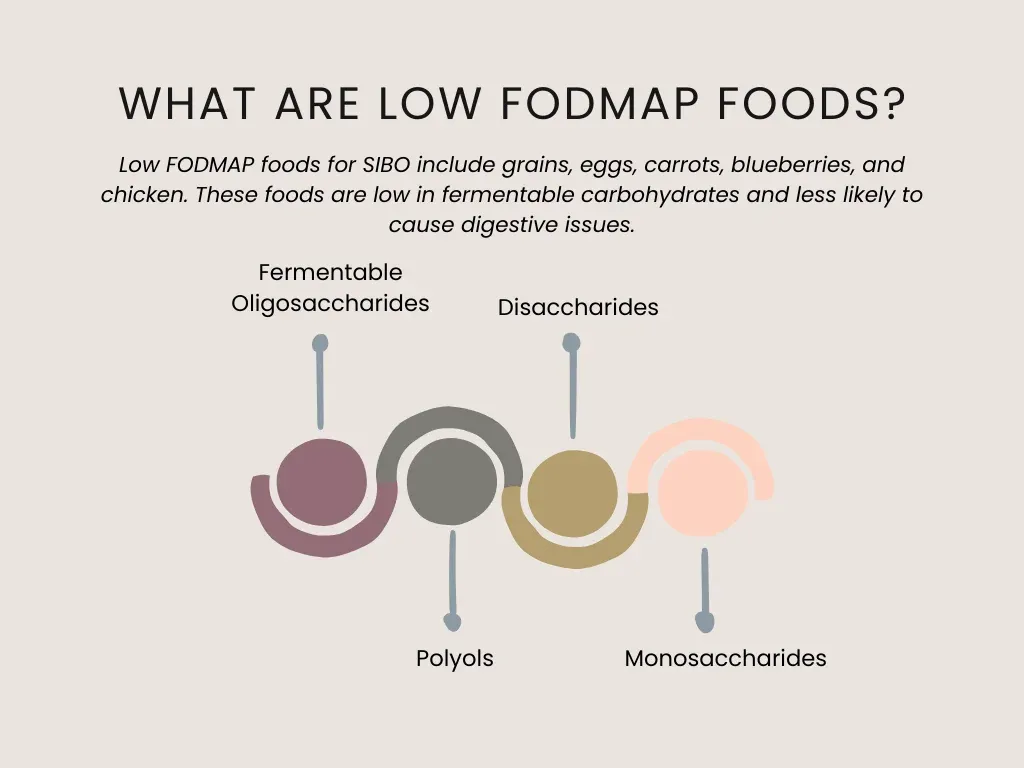
Low FODMAP foods for SIBO include grains, eggs, carrots, blueberries, and chicken. These foods are low in fermentable carbohydrates and less likely to cause digestive issues. Opting for these foods is recommended for people with irritable bowel syndrome or gastrointestinal disorders, alleviating symptoms like bloating, diarrhea, and abdominal pain.
For more comprehensive insights, let’s find out what FODMAP stands for.
Fermentable Oligosaccharides
These are a type of carbohydrates that can be found in onions, garlic, and wheat. Bacteria in the gut can break down carbohydrates like this, producing gasses as byproducts. This process can then lead to bloating, gas, and discomfort in some people with SIBO. To reduce the symptoms, managing the intake of fermentable oligosaccharides is an effective solution.
Disaccharides
Disaccharides are carbohydrates that are composed of two sugar molecules that are linked together. An example of this is lactose found in dairy products. Individuals with lactose intolerance don’t have the enzyme lactase needed to break down lactose, leading to symptoms like bloating, cramps, and diarrhea.
Monosaccharides
Examples of monosaccharides are fructose found in fruits, honey, and sweeteners like high-fructose corn syrup. Unlike table sugar, made of two sugars stuck together, fructose is a single molecular sugar. People with SIBO can have tummy troubles like feeling bloated or grassy if they overeat fructose-rich foods.
Polyols
Polyols are also known as sugar alcohols. They are commonly found in sugar-free products and fruits like apples. Sorbitol, mannitol, and xylitol are examples of polyols. Utilizing this element can lead to gastrointestinal issues when poorly absorbed in the small intestine, especially when consumed in large amounts.
5 Examples of low FODMAP foods for SIBO Management
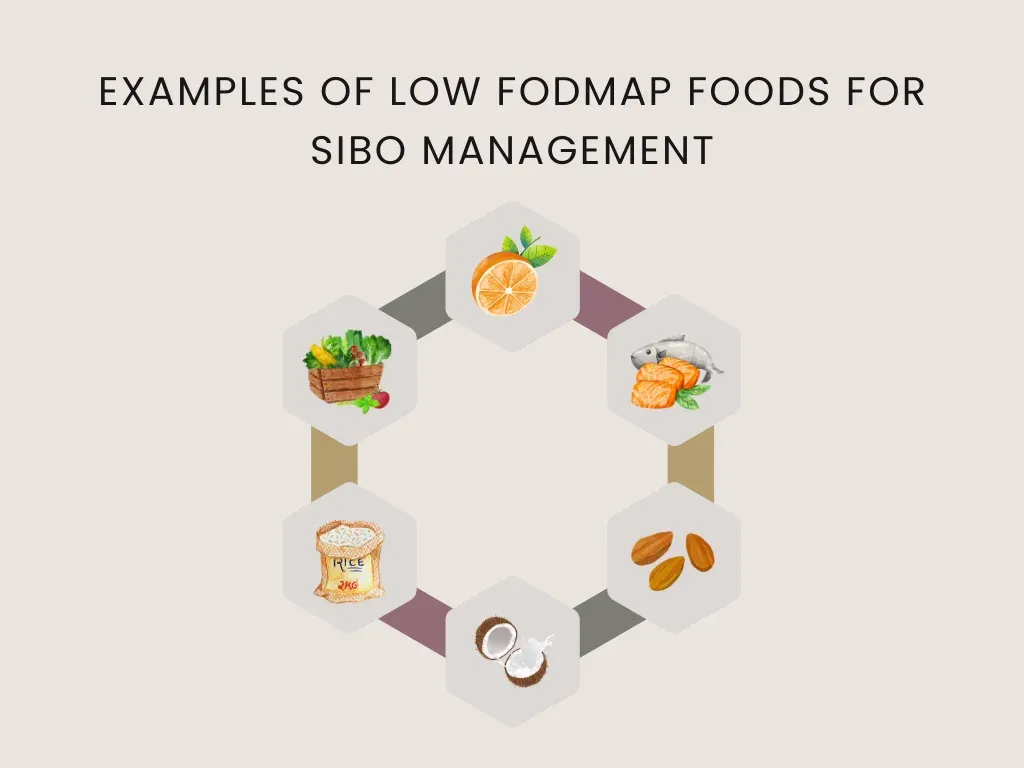
Knowing the top foods for low FODMAP is crucial to lessen digestive discomfort. Individuals with SIBO can add these foods into their diet to limit the food source for overgrowth bacteria. Here, we carefully selected foods that consist of lower fermentable carbohydrates.
Vegetables
Vegetables are suitable for a low FODMAP SIBO diet as they provide vital nutrients without worsening symptoms. Their fiber content supports a healthy balance of gut bacteria. Onions and garlic are some high-FODMAP vegetables that should be avoided so as not to trigger digestive distress for individuals with SIBO.
Let’s explore the vegetables regarded as with low FODMAP:
- Carrots: Carrots are rich in beta-carotene, a precursor to vitamin A. They are high in fiber, which is beneficial for digestion and gut health without causing excessive fermentation.
- Zucchini: Zucchini is a non-starchy vegetable with a high water content. It contains vitamins C and K and antioxidants like lutein and zeaxanthin.
- Spinach: Spinach is a nutrient-dense vegetable that provides iron, vitamins A and K, and antioxidants. Its low FODMAP status makes it suitable for those with digestive sensitivities.
- Bell Peppers: Bell peppers offer a range of nutrients, including vitamin C, vitamin A, and fiber. They add flavor and color to dishes without contributing to FODMAP-related symptoms.
- Cucumbers: Cucumbers are high in water and low in carbohydrate content. They are a good source of hydration, vitamin K, and antioxidants while being gentle on the digestive system.
Fruits
Individuals looking for low FODMAP foods should consider taking in fruits as they support good nutrition without causing distress during digestion. However, some fruits are high in fermentable carbohydrates like fructose and sorbitol, which can worsen symptoms. Choosing low FODMAP fruits supports digestive health and reduces discomfort.
Here are five common fruits that are considered low FODMAP:
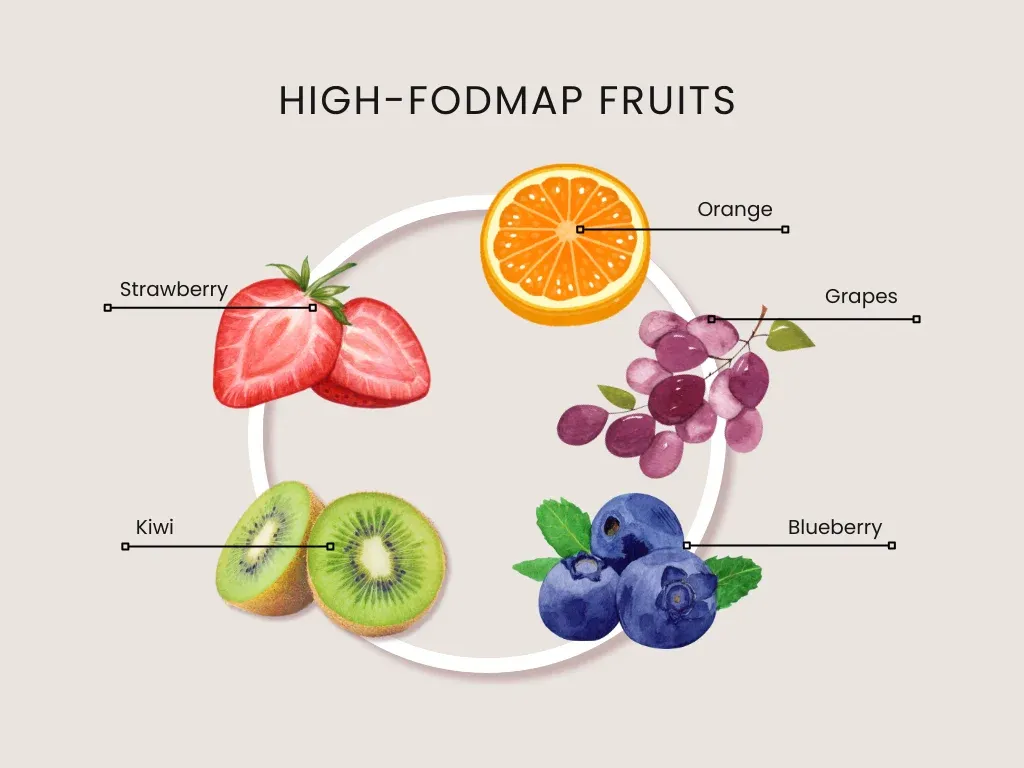
- Strawberries: These fruits are low in fermentable sugars, making them an excellent choice for those following a low FODMAP diet for SIBO.
- Kiwi: Kiwi is another low FODMAP fruit rich in vitamin C and fiber, which can support digestive health without aggravating symptoms.
- Blueberries: Blueberries are low in fermentable carbohydrates and provide antioxidants, making them a healthy choice for SIBO management.
- Oranges: Oranges are usually easier to digest for many individuals with SIBO due to their lower FODMAP content than other fruits.
- Grapes: When eaten in moderation, grapes are among the low FODMAP fruits that offer a sweet treat with minimal digestive discomfort, especially for those with SIBO.
Foods High in Protein
When managing SIBO with a low-FODMAP diet, selecting protein sources that are naturally low in FODMAP is essential. Protein sources suitable for SIBO management are typically lean and free from added sugars, sauces, or seasonings. Some examples of these are the following:
- Chicken: Lean chicken breast is a low FODMAP food that provides high-quality protein without added sugars. It can be grilled, baked, or sautéed for a delicious and gut-friendly meal.
- Turkey: Like chicken, turkey is a lean protein choice and can be prepared in various ways. To ensure it's low FODMAP, stick with plain, unseasoned turkey cuts.
- Fish: Many types of fish are naturally low in FODMAPs, such as salmon, cod, and tilapia. Fish is a good source of protein, omega-3 fatty acids, and minerals.
- Tofu: Tofu is a plant-based protein low in FODMAPs and suitable for vegetarian or vegan diets. It can be used in stir-fries, salads, or as a meat substitute in dishes while providing protein and texture.
- Eggs: Eggs are a versatile and low FODMAP protein option that can be enjoyed in various ways, such as boiled, scrambled, or poached. They are rich in protein, vitamins, and minerals.
Grains
Grains are a staple food group that can be included in low FODMAP foods for SIBO management. When using it for a low FODMAP diet, it is important to select grains that are lower in fermentable carbohydrates. Low FODMAP grains contain fewer fructans. Meanwhile, whole grains provide fiber, vitamins, and minerals while gentle on the digestive system. Below are examples of grains to consider:
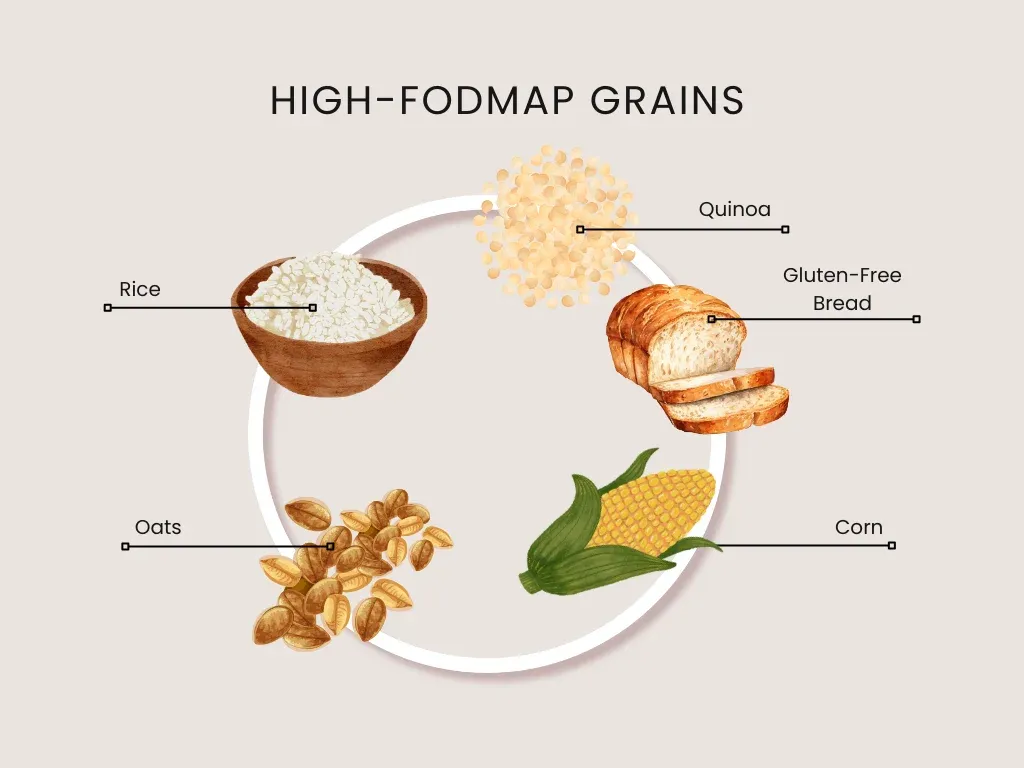
- Quinoa: Quinoa is a nutritious grain that is naturally gluten-free. It provides protein, fiber, and essential amino acids, making it a gut-friendly SIBO management option.
- Rice: White rice and specific types like jasmine rice are easily digestible. White rice can be a staple in a low FODMAP diet because it provides energy and carbohydrates without worsening digestive symptoms.
- Oats: Oats can be low FODMAP when consumed in small amounts, especially if certified gluten-free. While they offer fiber, vitamins, and minerals, it’s important to monitor portion sizes to avoid potential issues.
- Gluten-Free Bread: Some gluten-free breads like rice flour or tapioca starch are considered low FODMAP flour. These bread options can be suitable for sandwiches, toast, or as a side to meals.
- Corn: Corn-based products like cornmeal or polenta can provide carbohydrates without high FODMAP content. Corn is a versatile ingredient that can be used in various recipes.
Dairy Alternatives
Dairy alternatives offer essential nutrients like calcium, vitamin D, and protein. Choosing dairy alternatives labeled “lactose-free” or “low FODMAP” is important to ensure they suit a SIBO-friendly diet. Here are the dairy alternatives to consider:
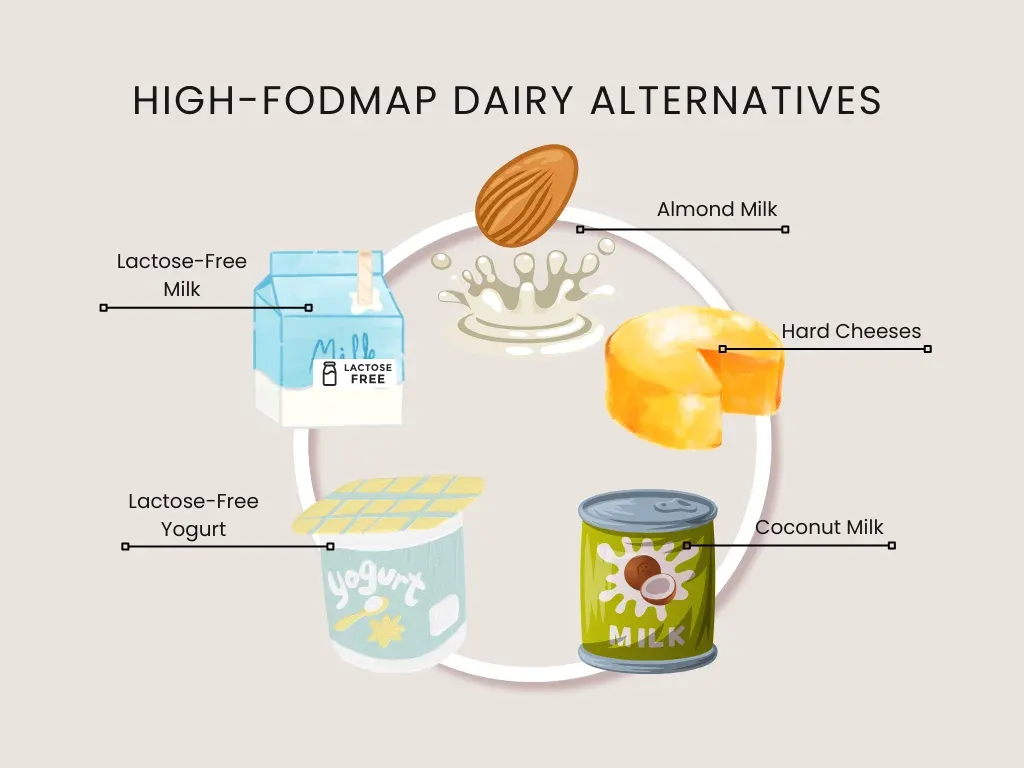
- Lactose-Free Milk: Lactose-free milk is suitable for those with lactose intolerance. It contains the same nutrients as regular milk without the lactose sugar that can cause digestive issues.
- Almond Milk: Almond milk can be a good source of calcium and vitamin E. It is a popular dairy-free option for individuals following a low FODMAP diet.
- Lactose-Free Yogurt: Lactose-free yogurt provides probiotics and protein without the lactose content found in regular yogurt. It can be a beneficial addition to a SIBO-friendly diet for gut health.
- Hard Cheeses (like Cheddar): Hard cheeses like cheddar are typically lower in lactose and can be tolerated by some individuals with lactose intolerance. Hard cheeses are a good source of calcium and protein.
- Coconut Milk: Coconut milk is naturally low in FODMAPs and can be used in cooking and baking as a dairy alternative. It adds a creamy texture and a subtle coconut flavor to dishes.
Nuts and Seeds
Nuts and seeds are nutrient-dense foods that can be part of a low FODMAP diet. While some nuts and seeds are high in FODMAPs due to their oligosaccharide content, others are considered low and can be consumed in moderation. Portion control is critical when adding nuts and seeds into a low FODMAP diet.
Nuts and seeds which has low FODMAP foods for SIBO are the following:
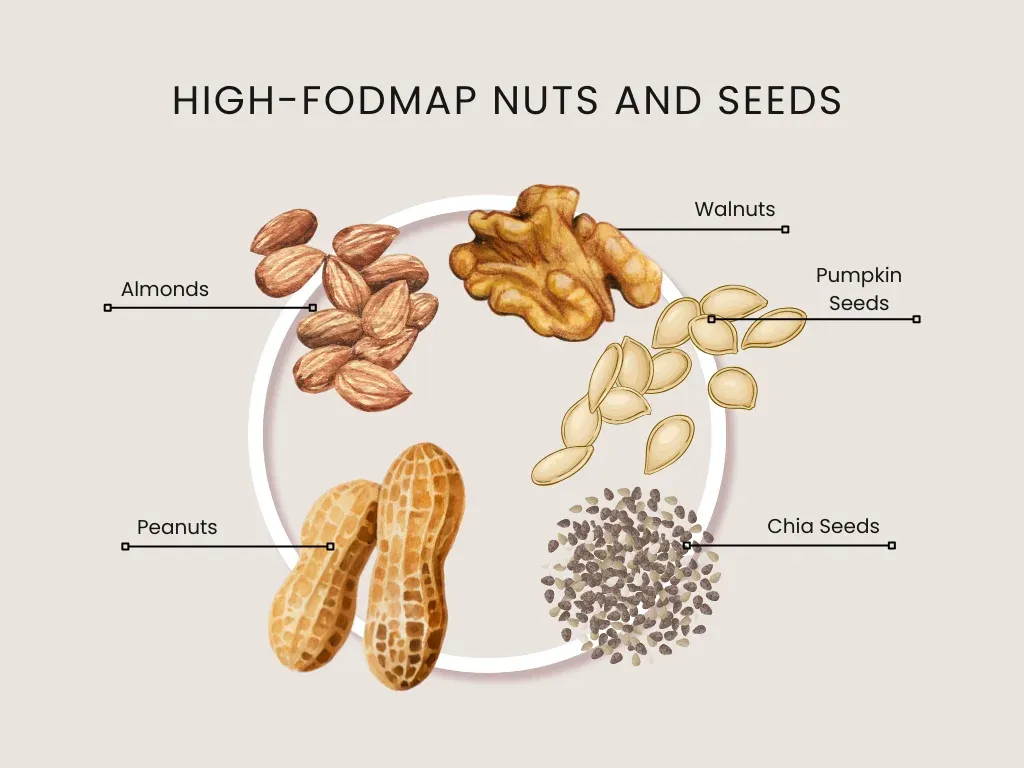
- Almonds: Almonds are a low FODMAP nut option when consumed in small portions. They are a good source of healthy fats, protein, and vitamin E.
- Peanuts: Peanuts are low in FODMAP and provide protein and healthy fats. Peanut butter made from peanuts without added sugars or high FODMAP ingredients can also be a suitable choice.
- Walnuts: Walnuts are low in FODMAP and contain omega-3 fatty acids, which are beneficial for heart health. Typically, they are sprinkled on salads or used in baking for added texture and flavor.
- Pumpkin Seeds: Pumpkin seeds are low in FODMAP and rich in nutrients like magnesium, zinc, and protein. These seeds can be roasted and enjoyed as a snack or used as a topping for yogurt or oatmeal.
- Chia Seeds: Chia seeds are low in FODMAP and packed with fiber, omega-3 fatty acids, and antioxidants. With their ability to be soaked in liquid, they create a gel-like consistency.
How a Low FODMAP Diet Can Help With Long-term SIBO Management

A low FODMAP diet can work wonders for the long-term management of SIBO. It offers relief and promotes a healthier gut environment. Let’s explore how a low FODMAP diet can help with long-term SIBO management.
Reduces Flare-Ups
Reducing flare-ups is a significant advantage of relying on low-FODMAP foods for SIBO management. These flare-ups often occur due to gut bacteria’s rapid fermentation of specific carbohydrates. A low FODMAP diet aims to lessen the burden on the digestive tract by excluding foods that ferment quickly or cause digestive distress.
Supports Gut Healing
A low FODMAP diet isn’t just about avoiding triggers; it’s also about giving your gut a chance to heal by reducing irritation and inflammation. Because of this, you’re creating the perfect conditions for your digestive system to rebuild and repair itself. However, this diet emphasizes consuming nutrient-dense foods that support gut health.
Balances Gut Microbiota
For long-term SIBO management, keeping your gut bacteria balanced is super important. Consuming low FODMAP foods for SIBO management helps because it deals with those carbs that can mess up your gut bacteria balance. Doing this stops the harmful bacteria from growing too much, which can cause SIBO symptoms.
Improves Nutrient Absorption
Eating low FODMAP foods for SIBO can improve your body’s nutrient absorption. When your digestive system is less stressed from high FODMAP foods, it can focus on breaking down nutrients effectively. This helps your body use vitamins, minerals, and other essentials to stay healthy and energized.
Enhances Treatment Outcomes
A low FODMAP diet can enhance treatment outcomes for long-term SIBO management by focusing on dietary changes. These changes aim to reduce various symptoms such as bloating, gas, and abdominal pain, which lead to an improved quality of life. Furthermore, low FODMAP foods for SIBO reduce dietary triggers and optimize the effectiveness of medical interventions.
FAQs
Does a low FODMAP diet starve bacteria?
A low FODMAP diet doesn’t starve bacteria entirely but somewhat limits their food source by reducing fermentable carbohydrates. This restriction can help rebalance gut flora and reduce symptoms associated with SIBO.
How do I know if a low FODMAP diet is effective?
You can assess the effectiveness of a low FODMAP diet by monitoring improvements in digestive symptoms such as bloating, gas, and abdominal discomfort. Additionally, tracking changes in bowel habits and overall gut comfort can indicate whether the diet works for you.
How long should you stay on the low FODMAP diet?
It’s recommended to follow a low FODMAP diet under the guidance of a healthcare professional, typically for about 2 to 6 weeks. After this, foods are systematically reintroduced to identify specific triggers and create a sustainable, personalized eating plan.
Conclusion
Knowing the top low FODMAP foods for SIBO management is beneficial to lessen SIBO symptoms like bloating, gas, and abdominal discomfort. These foods can be complemented with medical interventions like antibiotic therapy or probiotics, providing a more holistic treatment plan. These not only address current symptoms but also work towards preventing future flare-ups.
Consistently following this combined method can lead to improvements in your overall gut health and quality of life. However, during this dietary process, monitoring symptoms and working with a healthcare professional to track progress and tailor interventions are key to a more effective SIBO management.
Looking for a supplement to include in your low FODMAP foods for SIBO? Consider using Nudge’s specialized supplement offering motility-activating agents. These include ginger root, artichoke stem extract, and lemon balm for optimal gut health support. Reach out to our experts via contact@nudgehealth.co to learn more or start your 15-day free trial today.